
Browse an alphabetical list of photographs. These historical images portray people, places, and events before, during, and after World War II and the Holocaust.
<< Previous | Displaying results 2251-2300 of 2641 for "Photo" | Next >>
Stall of a street vendor selling old Hebrew books. Warsaw ghetto, Poland, February 1941.
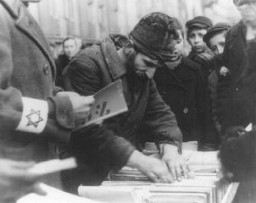
Gerd Zwienicki studies outside the Würzburg Jewish teachers seminary shortly before it was closed down on Kristallnacht. Würzburg, Germany, 1938.
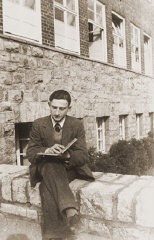
Students and members of the SA with armfuls of literature deemed "un-German" during the book burning in Berlin. Germany, May 10, 1933.
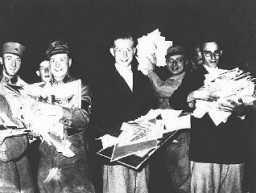
Students and members of the SA unload books deemed "un-German" during the book burning in Berlin. The banner reads: "German students march against the un-German spirit." Berlin, Germany, May 10, 1933.
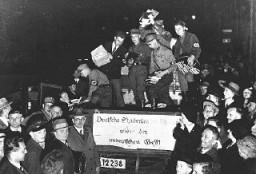
Group portrait of students and teachers at the Hebrew gymnasium in Munkacs. 1936-1937.
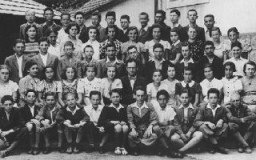
Across Germany, students took books by truck, furniture van, even oxcart, and heaped them into pyres on public squares. This image shows members of the SA and students from the University of Frankfurt with oxen pulling manure carts loaded with books deemed "un-German." Frankfurt am Main, Germany, May 10, 1933.
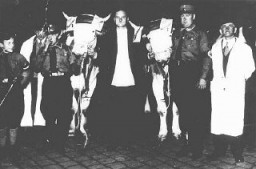
Class photo of students and a teacher at a Jewish school in prewar Karlsruhe. Germany, July 1937.
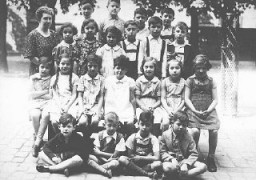
Studio portrait of Chava Leichter, murdered in the Treblinka killing center in 1942 at the age of 25. Her brother Chaim emigrated to Palestine in 1937 on the boat Polania. He served in the British army in Libya during the war. This photograph was taken in 1939.
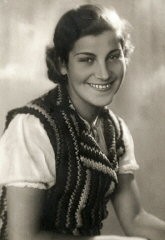
Studio portrait of Jankl Zuckerkandel, taken in The Hague, the Netherlands, in or around 1941. Jankl was killed in Sobibor at the age of three.
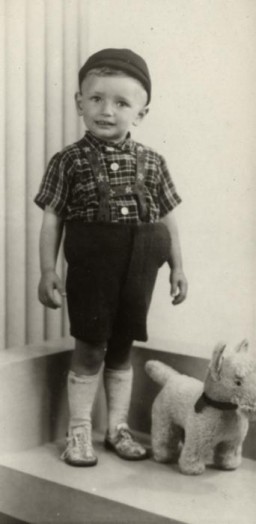
Obersturmführer Karl Höcker, June 21, 1944. Karl Höcker, adjutant to the commandant of Auschwitz, kept a photograph album. The album includes both documentation of official visits and ceremonies at Auschwitz as well as more personal photographs depicting the many social activities that he and other members of the Auschwitz camp staff enjoyed. These rare images show Nazis singing, hunting, and even trimming a Christmas tree. They provide a chilling contrast to the photographs of…
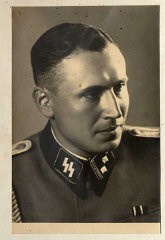
Theresia Seibel, born in 1921, was a member of the Sinti froup (Sinti and Roma are two main groups that make up the Romani, or Gypsy, ethnic minority). Theresia joined Germany’s Wuerzburg Stadttheater at age 16, performing as a singer and dancer. In 1941, she defied Gestapo orders to be sterilized and was three months pregnant with twins by the time she was called in for the procedure. She was allowed to continue the pregnancy on the condition that the babies would be given at birth to the clinic…
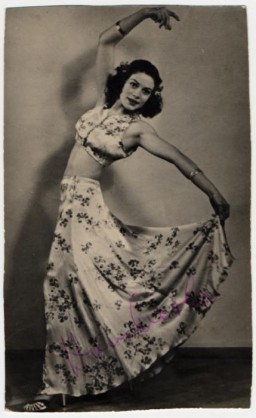
Prewar wedding portrait of Reine and Yishua Ghozlan in Constantine, Algeria, on March 29, 1932. The couple experienced antisemitism in the prewar years, and in 1933 Reine and Yishua survived a deadly pogrom by hiding with French Christian friends. After the start of World War II, Yishua was thrown out of his position in the post office. Reine, Yishua, and their children were evicted from their apartment.

Prisoners of the Stupki forced-labor camp for Jews in the Generalgouvernement. Stupki, Poland, 1941–42.
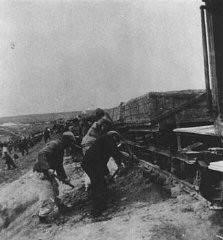
View of the Biesinitzer Grund (Goerlitz) concentration camp, a subcamp of Gross-Rosen, after liberation. Poland, May 1945.
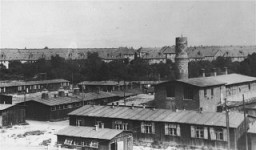
Suitcases that belonged to people deported to the Auschwitz camp. This photograph was taken after Soviet forces liberated the camp. Auschwitz, Poland, after January 1945.
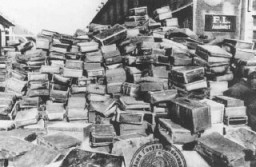
The Reich Union of Jewish Frontline Soldiers organized summer camps and sports activities for Jewish children. Germany, between 1934 and 1936.
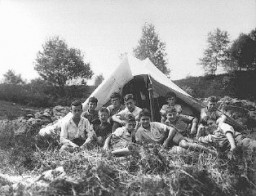
Boxes of matzah in a Joint Distribution Committee warehouse before distribution to Jewish survivors in displaced persons camps. Place uncertain, postwar.
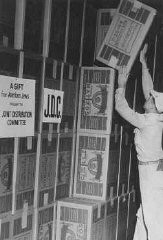
Morris Laub (right), American Jewish Joint Distribution Committee director for Cyprus, reviews supplies sent for the 12,000 Jews still interned on the island. Cyprus, December 9, 1948.
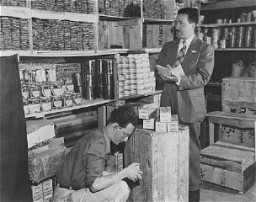
Exterior view of the ORT (Organization for Rehabilitation through Training) supply and transport building in the Foehrenwald displaced persons camp. Foehrenwald, Germany, 1953. This slide was taken by David Rosenstein during his inspection tour of the camp. After his return from the inspection tour in 1953, he briefed Congress on the plight of the remaining Jewish displaced persons in Europe and their inability to find permanent homes, nine years after the end of the war.
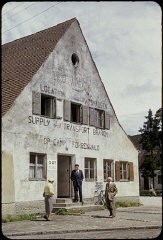
Surrendered Germans in Austria. May 1945. US Army Signal Corps photograph taken by J Malan Heslop.
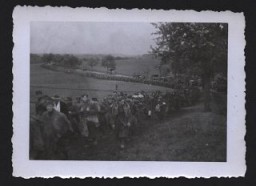
A war crimes investigation photo of the disfigured leg of a survivor from Ravensbrück, Polish political prisoner Helena Hegier (Rafalska), who was subjected to medical experiments in 1942. This photograph was entered as evidence for the prosecution at the Medical Trial in Nuremberg. The disfiguring scars resulted from incisions made by medical personnel that were purposely infected with bacteria, dirt, and slivers of glass.
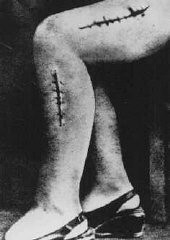
Jewish female survivors at a convalescent home. Sweden, 1946.
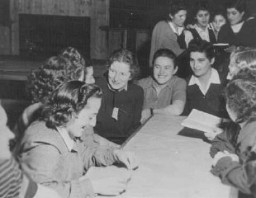
Survivors in a barracks at the Wöbbelin concentration camp. Germany, May 4–5, 1945.
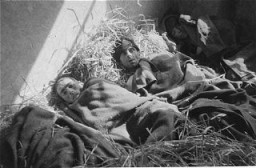
Survivors in Buchenwald just after liberation. Troops of the US 6th Armored Division entered Buchenwald on April 11, and troops of the 80th Infantry arrived on April 12. Buchenwald, Germany, photograph taken ca. April 11, 1945.
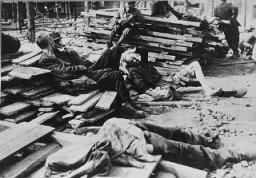
Survivors in Langenstein after the camp was liberated by the 83rd Infantry Division. Langenstein, Germany, April 17, 1945.
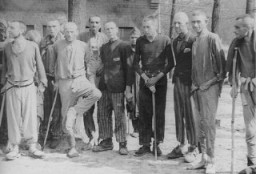
Two emaciated female Jewish survivors of a death march lie in an American military field hospital in Volary, Czechoslovakia. Pictured on the left is seventeen-year-old Nadzi Rypsztajn.The original caption reads "This girl, only seventeen years old, was forced to march 18 miles a day for 30 days on one bowl of soup a day. The 5th Infantry Division of the U.S. Third Army found 150 in the same condition when they entered Volary, Czechoslovakia."
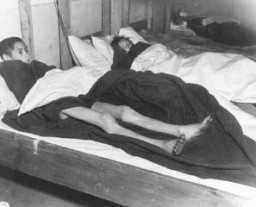
Survivors of the Ampfing subcamp of the Dachau concentration camp soon after liberation by US troops. Ampfing, Germany, May 4, 1945.
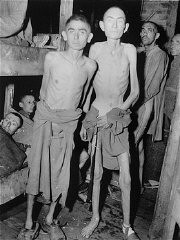
Soon after liberation, camp survivors wait for rations of potato soup. Bergen-Belsen, Germany, April 28, 1945.
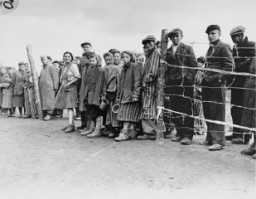
Emaciated survivors of the Buchenwald concentration camp soon after the liberation of the camp. Germany, after April 11, 1945.
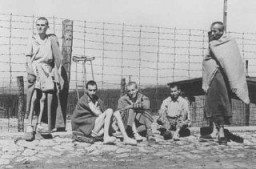

Emaciated survivors in the Ebensee subcamp of the Mauthausen concentration camp suck on sugar cubes provided by US soldiers upon the liberation of the camp. Photograph taken by Signal Corps photographer J Malan Heslop. Ebensee, Austria, May 8, 1945.
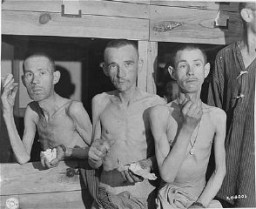
Survivors of the Ebensee subcamp of the Mauthausen concentration camp. Ebensee, Austria, May 8, 1945.
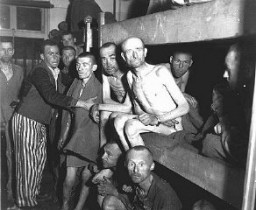
Survivors of the Buchenwald concentration camp gather around trucks carrying American troops. Germany, May 1945.
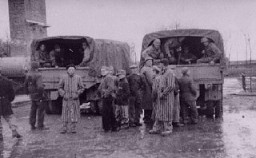
Two survivors of the Dora-Mittelbau concentration camp, located near Nordhausen. Germany, April 14, 1945.
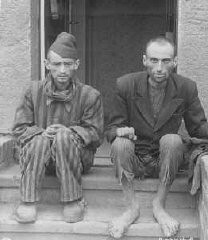
Emaciated survivors of the Mauthausen concentration camp soon after the liberation of the camp. Austria, May 1945.
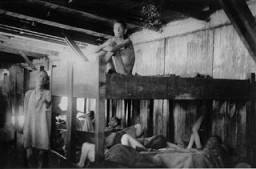
Five Jewish survivors pose for a US Signal Corps photographer in front of Block 2 in the Hanover-Ahlem camp, a subcamp of Neuengamme. Hanover-Ahlem, Germany, April 11, 1945.
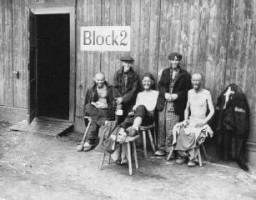
Soon after liberation, camp survivors cook in a field. Bergen-Belsen, Germany, after April 15, 1945. In the days before liberation, the prisoners had been left without food or water. More than 13,000 inmates died in the three months following liberation.
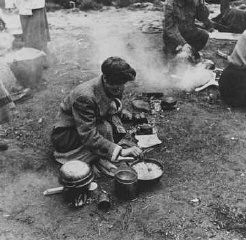
Survivors waiting for to be evacuated from the Wöbbelin concentration camp to receive medical attention at a field hospital. Germany, May 4, 1945.
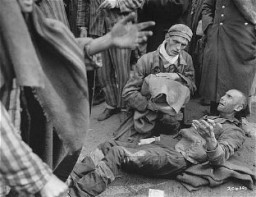
Photograph taken in December 1932 of Suse Grunbaum at age one. Soon after Hitler's 1933 seizure of power in Germany, two-year-old Suse and her parents fled to the Netherlands and settled in the town of Dinxperlo. In 1943, Jews in German-occupied Dinxperlo were ordered to assemble for deportation. Hearing of these plans, the Grünbaums went into hiding, finding refuge with Dutch farmers. The Hartemink family hid Suse and her mother for two years in their barn, first under the floorboards, then in a…
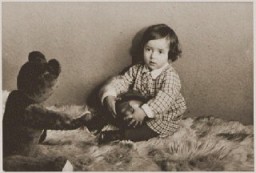
German (swastika) and Olympic flags fly in Berlin during the Olympic Games. Berlin, Germany, August 1936.

A flag bearing a swastika is raised over the city hall in Sarajevo after German forces captured the city. Sarajevo, Yugoslavia, April 16, 1941.

Members of a German military unit swear allegiance to Adolf Hitler. Germany, date uncertain.
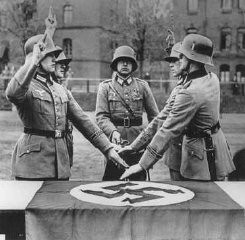
Swedish "protective pass" issued to Lili Katz, a Hungarian Jew. The document was initialed by Raoul Wallenberg (bottom left). Budapest, Hungary, August 25, 1944.
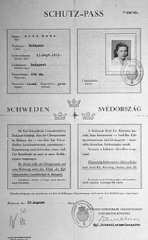
Swedish protective pass issued to Joseph Katona, the Chief Rabbi of Budapest. Budapest, Hungary, September 15, 1944.

Members of the United States Holocaust Memorial Council pose with two milkcans containing a Scroll of Remembrance signed by Holocaust survivors at a symbolic groundbreaking ceremony for the United States Holocaust Memorial Museum. Benjamin Meed is second from the left. Washington, DC, April 30, 1984. During groundbreaking ceremonies in April 1985, the containers were buried on the site of the Museum.
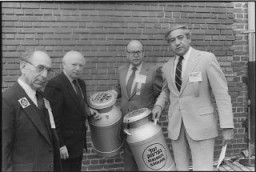
Sephardic synagogue destroyed during the January 21-23 Iron Guard pogrom. Bucharest, Romania, January 1941.
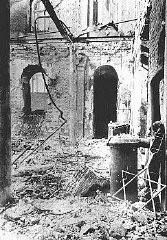
Interior of a synagogue destroyed during Kristallnacht (the "Night of Broken Glass"). Dortmund, Germany, November 1938.
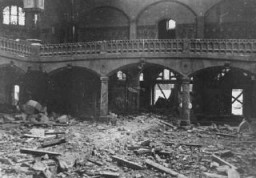
As the synagogue in Oberramstadt burns during Kristallnacht (the "Night of Broken Glass"), firefighters instead save a nearby house. Local residents watch as the synagogue is destroyed. Oberramstadt, Germany, November 9-10, 1938.
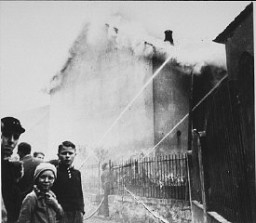
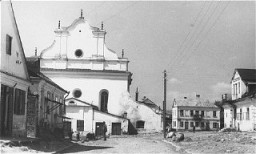
The New Synagogue in Trieste, Italy. It opened in 1912 and was desecrated by the Nazis on July 18, 1942. Trieste, Italy, July 18, 1942.
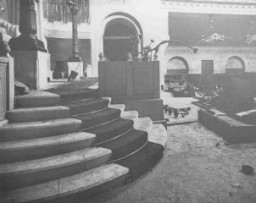
We would like to thank Crown Family Philanthropies, Abe and Ida Cooper Foundation, the Claims Conference, EVZ, and BMF for supporting the ongoing work to create content and resources for the Holocaust Encyclopedia. View the list of donor acknowledgement.